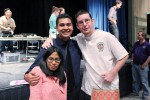This post was updated Nov. 1 at 6 p.m.
UCLA researchers and students are finding novel ways to battle the stigma of autism and diagnose the disorder.
In the spring, UCLA’s Center for Autism Research and Treatment partnered with the Simons Foundation Powering Autism Research for Knowledge, an online genetics study that aims to advance understanding of autism spectrum disorder, said Amanda Gulsrud, a child and adolescent psychiatry professor.
Gulsrud said she and her team develop methods that allow researchers to identify developmental delays in toddlers and young children that may lead to autism. She said ASD is characterized by social impairments, such as lack of eye contact and repetition of movements.
[Related: UCLA student initiative Rockin’ Autism combines sport with therapy]
Gulsrud said she thinks social research into the disorder is important because it can lead to a better understanding of the spectrum of autism and its diverse effects. She added she thinks identifying distinctive traits early on can help optimize treatment for children with autism.
“I never think about a blanket treatment for everyone,” Gulsrud said. “I never think of our research in terms of a cure or an absolute.”
She added she thinks autism researchers need to study a larger sample size to accurately characterize the diversity of the disorder.
“In the past, genetics research has been really limited because of sample size as well as a lack of (racial) diversity,” Gulsrud said. “We want to do a better job of reaching all the different forms of diversity as well as making sure our genetic research reflects that diversity.”
Joshua Sarna, a fourth-year chemistry student and representative for Best Buddies at UCLA, said he thinks autism encompasses a wide variety of characteristics within individuals. Best Buddies is an international organization dedicated to ending the stigma against people with intellectual and developmental disabilities.
“Autism has such a broad definition,” said Sarna. “It can affect people socially, depending on the individual.”
Sarna said he thinks social stigma regarding autism is universal and that many people don’t know how to interact with students who have developmental disabilities.
“A friend of mine is nonverbal (and) has to type everything,” Sarna said. “Some have difficulty speaking. … (Students and adults should) keep an open mind (and) not assume that someone cannot do something.”
Sarna added that he thinks if people can normalize these disabilities in the long term, social stigma can decrease and disabilities can become more visible and accepted.
“It takes more effort to exclude someone than to include them,” Sarna said. “We don’t need to start acceptance, we just need to stop steering away from acceptance.”
Sarna said he thinks people with disabilities should be provided with necessary technologies that would help with accessibility. For example, he said he thinks making buildings accessible to physically handicapped individuals will make them feel more welcome.
“There are hurdles that individuals still face despite acceptance,” Gulsrud said. “For example, individuals with autism can still face severe communication limitations.”
Gulsrud is currently reaching out to Latino and Black communities in South Los Angeles in order to raise awareness of autism as well as to collect vital information for her research.
